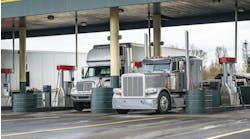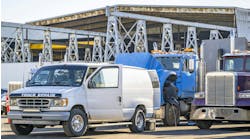Back to basics: Proper maintenance and fuel strategies for fleets
Today’s fuel prices have reintroduced a bevy of asset management challenges for fleets that significantly impact the bottom line of every organization. This is especially a concern since fuel is the largest component of total cost of ownership (TCO) for any fleet. And while it is challenging to procure new trucks, it’s equally important to have a solid fuel economy and maintenance strategy to identify where costs are eroding the bottom line.
A significant problem facing the industry is that many fleets still do not use data analytics to pinpoint their diesel cost per mile (CPM), and instead continue focusing on diesel cost per gallon. Companies must analyze their electronic logging device and maintenance data to determine key performance indicators (KPIs) such as fuel economy and miles-per-gallon (mpg) per model year, mile-per-year analysis by model year, and fleet utilization by miles to establish a baseline.
This approach, combined with a fleet modernization plan and corresponding fleet services support, can help keep a fleet’s cost per mile in line.
Effects of extending truck life cycles and the future of procurement
According to Steve Smith, senior industry adviser at DDC FPO and president of Smith Transportation Consulting Services, when the economy starts to slow down, the industry’s knee-jerk reaction is to extend the life of equipment, he noted at the recent ATA MCE 2022 conference. “However, extending the life of a tractor could help fleets save capital in the short term, but eliminate cashflow due to the cost of repairs.”
Unfortunately, according to the NPTC, many private fleet respondents report they were forced to extend their equipment trade cycles due to the unavailability of equipment.
CPM historical trends have increased dramatically over the past few years, and several key drivers must be tracked to independently understand how they impact profits and losses. This includes cost increases on parts, service, and fuel when trade cycles are extended. This will lead to maintenance being performed at a higher rate but also on components typically not addressed in a shorter life cycle, where parts and service have seen a 10% to 20% cost increase depending on component. Fuel has been volatile with cost increases and decreases of more than 25% in a quarter and trying to forecast future costs can be a challenge. This is why it’s recommended to focus on a controllable baseline. For example, fuel planning should be based on gallons used and not price. This allows fleets to maintain operating controls during times of price variation. Parts can be tracked by VMRS code and frequency. Older vehicles can be used as a benchmark to determine planned expenditures, and many industry trade organizations and the right asset management partner can provide industry vertical data.
Ultimately, a data-driven life cycle cost management plan helps corporate fleets make measurable changes in both the financial and environmental bottom line. The average driving mpg for a 500-unit fleet operating a five-year life cycle is 8.41, while the average for an eight-year cycle is 7.90. Organizations have switched from an eight- to five-year life cycle, resulting in a net reduction of 2,494,770 gallons of fuel.
Back to basics: fuel strategies
That gap created from running vehicles longer results in increased fuel spend, increased carbon output, and more cost overall, eating into profits. So, as we’re thinking about managing our life cycle and mitigating cost in these challenging times, there are several things to consider when it comes to fuel.
It’s important to understand how a dual MPG on tractors works for both newer and older models. There is a minimal break-in period for newer units, but it’s not like it used to be 10- or 15-years ago when we saw a half-mile penalty. Today they start at 8.41 per gallon, and as the vehicle enters the end of its life cycle, you will typically see fuel degradation. As you think about managing a life cycle, you can’t base your procurement cycle one year out. Therefore, you must have a multi-year approach and one-, three-, and five-year plan for equipment replacement.
Proper maintenance reduces M&R and fuel costs
If you previously operated a truck for four or five years and are now dealing with supply chain challenges, you will be required to stretch that truck for six or seven years, and the maintenance you perform on that truck will be different.
Trucks that operate for four or five years, typically under warranty, may have an aftertreatment system short of fueling with regeneration or possibly one cleaning the diesel particulate filter (DPF) system. Fleets that operate longer life cycles must overcome additional challenges for their fuel strategy and the broader fuel management system, tires, etc. Tires are particularly significant because a longer life cycle can impact replacement cycles, the type of tires, and service and repair costs over a more extended period.
Furthermore, fleets may also find they need to replace their one box system, which is the box that holds the DPF filters on Class-8 tractors. This may result in error codes for their DPF system, causing regenerations to increase. When this occurs, drivers must stop more often to regenerate the system between 30 and 45 minutes, which can adversely impact their business. This eventually results in DPF filter replacement along with components such as crossover pumps, dosage valves, and in some cases crossover tubes—line-item expenses that add up significantly over time.
However, if truck life cycles are extended but preventive maintenance cycles aren’t realigned, your entire maintenance and repair operation may no longer be in sync with third-party provider recommendations in regards to internal mechanics and key operating components, which negatively affects each truck’s performance.
Data analytics and these strategies will help you better understand the big picture and how today’s fuel prices and life-cycle extensions impact your cost structures. You’ll also be able to pinpoint at the line-item level where specific expenditures are adding up.
Al Barner, certified treasury professional, is SVP of strategic fleet solutions for Fleet Advantage, a provider of fleet business analytics, equipment financing, and life cycle cost management.



